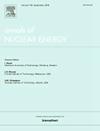Comparison between EDF MAAP5.04 and ASTECV3 codes on a hypothetical severe accident on the ELSMOR project E-SMR design
IF 1.9
3区 工程技术
Q1 NUCLEAR SCIENCE & TECHNOLOGY
引用次数: 0
Abstract
This paper presents a comparison between EDF MAAP 5.04 and ASTECv3 codes for a hypothetical severe accident leading to core degradation in the ELSMOR project’s proposed E-SMR (Small Modular Reactor) design. The ELSMOR (Towards European Licensing of Small Modular Reactors) project was a Horizon 2020 Euratom project that ended in 2023. The consortium included 15 partners from 8 European countries, involving research institutes, major European nuclear companies, and technical support organizations. The 3.5-year project, launched in September 2019, investigated selected safety features of Light-Water (LW) SMRs with a focus on licensing aspects.
The Modular Accident Analysis Program (MAAP) is a deterministic code owned and licensed by the Electric Power Research Institute (EPRI) that simulates the response of light water moderated nuclear power plants during accidental transients. ASTEC v3, developed by IRSN, is a severe accident system code used to evaluate major nuclear accidents for different nuclear installations, focusing on western light water reactor designs.
This study compares EDF MAAP5.04 and ASTECv3 in terms of transient evolution from the initiating event (a Station Black Out), core degradation and hydrogen generation, corium relocation to the lower plenum, and in-vessel melt retention (IVMR). The comparison also includes physical phenomena in the containment, such as steam condensation on the walls. The potential for H2 combustion, based on the specific assumptions of the selected transient, is evaluated through flammability diagrams, and a sensitivity analysis of N2 injection for inerting the containment is assessed.
This study shows that both EDF MAAP 5.04 and ASTECv3 codes can effectively simulate severe accident phenomena and mitigation strategies like IVMR, containment inerting, and reactor decay heat removal. The codes generally agree well, providing key parameter magnitudes. Some modeling improvements were made, and remaining discrepancies are discussed. Sensitivity calculations are presented to confirm the analysis and to highlight model uncertainties, particularly for steam condensation and hydrogen production.
求助全文
约1分钟内获得全文
求助全文
来源期刊

Annals of Nuclear Energy
工程技术-核科学技术
CiteScore
4.30
自引率
21.10%
发文量
632
审稿时长
7.3 months
期刊介绍:
Annals of Nuclear Energy provides an international medium for the communication of original research, ideas and developments in all areas of the field of nuclear energy science and technology. Its scope embraces nuclear fuel reserves, fuel cycles and cost, materials, processing, system and component technology (fission only), design and optimization, direct conversion of nuclear energy sources, environmental control, reactor physics, heat transfer and fluid dynamics, structural analysis, fuel management, future developments, nuclear fuel and safety, nuclear aerosol, neutron physics, computer technology (both software and hardware), risk assessment, radioactive waste disposal and reactor thermal hydraulics. Papers submitted to Annals need to demonstrate a clear link to nuclear power generation/nuclear engineering. Papers which deal with pure nuclear physics, pure health physics, imaging, or attenuation and shielding properties of concretes and various geological materials are not within the scope of the journal. Also, papers that deal with policy or economics are not within the scope of the journal.
 求助内容:
求助内容: 应助结果提醒方式:
应助结果提醒方式:


